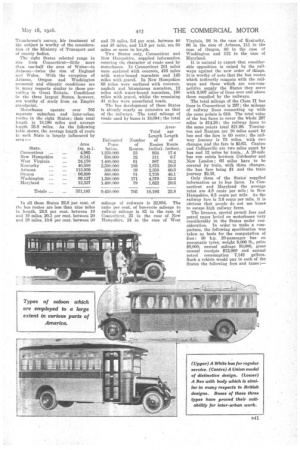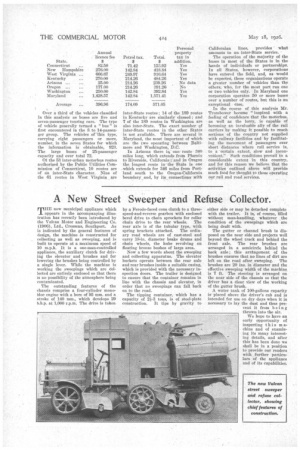THE BUS AND INTER-URBAN OPERATION.
Page 22

Page 23

Page 24

If you've noticed an error in this article please click here to report it so we can fix it.
An Analysis of Bus Operation in Eight American States Throws Light on the Potentialities of the Passenger Motor Vehicle.
ALTHOUGH the use of the motorbus as a medium of passenger transportation is a British "discovery," the most remarkable 'expansion of its use during recent years is to be found in the United States. Less than a decade ago only a few hundred vehicles, consisting mainly of comfortless and uninviting bodies adapted to passenger car and lorry chassis, were in operation. To-day 80,000 commodious, comfortable and well-designed buses operate over hundreds of thousands of main roads with all the regularity and punctuality of trains.
The growing use, of highways for passenger traffic is assuming such huge proportions that Mr. Henry R. Trumbower, the economist of the United States Bureau of Public Roads, has undertaken an exhaustive survey of these developments. He has recently published an analysis of bus operation in eight States, ignoring entirely all data relating to bus services in cities, and concentrating on bus use between cities and suburbs and between city and city. The eight States reviewed are Connecticut, New Hampshire, West Virginia, Kentucky, Arizona, Oregon, Washington and Maryland. Apart from the interest centring around Mr.
Trumbower's survey, his treatment of the subject is worthy of the consideration of the Ministry of Transport and of county bodies.
The. eight States selected range in size from Connecticut—little more than one-half the area of Wales---to Arizona—twice the size of England and Wales. With the exception of Arizona, Oregon and Washington economic and climatic conditions are in many respects similar to those prevailing in Great Britain. Conditions in the three largest States, however, are worthy of study from an Empire standpoint.
Motorbuses operate over 705 separate suburban and inter-urban routes in the eight States ; their total length is 18,196 miles and average length 25.8 miles. As the following table shows, the average length of route in each State is largely influenced by area :— In all these States 22.8 per cent. of the bus routes are less than nine miles in length, 28.8 per cent. between 10 and 19 miles, 20.3 per cent. between 20 and 29 miles, 10.6 per cent. between 80 and 39 miles, 5.6 per cent. between 40 and 49 miles, and 11.9 per cent. are 50 miles or more in length.
Two States only, Connecticut and New Hampshire, supplied information covering the character of roads used by motorbuses. In Connecticut 201 miles were surfaced with concrete, 476 miles with water-bound macadam and 145 miles with gravel. In New Hampshire 68 miles were surfaced with concrete, asphalt and bituminous macadam, 12 miles with water-bound macadam, 190 miles with gravel, whilst the remaining 41 miles were unsurfaced roads.
The bus development of these States is already nearly as extensive as that of the railways. The total mileage of roads used by buses is 18,094; the total mileage of railways is 22,994. The ratio per cent, of bus-route mileage to railway mileage is 82 in the case of Connecticut, 25 in the ease of New Hampshire, 24 in the case of West
Virginia, 98 in the case of Kentucky, 96 in the case of Arizona, 111 in the case of Oregon, 80 in the case of Washington and 112 in the case of Maryland.
It is natural to expect that considerable opposition is raised by the railways against the new order of things. It is worthy of note that the bus routes which indirectly compete with the railways and those which are non-competitive supply the States they serve with 9,807 miles of lines over and above those supplied by the railways.
The total mileage of the Class II bus lines in Connecticut is 297; the mileage of railway lines connecting up with the same points is 610. The total value of the bus fares to cover the vhole 297 miles is $14.20; the railway fares to the same points total $21.96. Torrington and Bantam are 10 miles apart by bus and the fare is 60 cents; the railway journey is '13 miles with two changes, and the fare is $2.63. Canton and Collinsville are two miles apart by bus and 12 miles by train. A 20-mile bus run exists between Colchester and New London; 66 miles have to be covered by train, with three changes, the bus fare being $1 and the train journey $2.38.
Only three of the States supplied information as to bus fares. In Connecticut and Maryland the average rates are 4.8 cents per mile ; in New Hampshire, 6.5 cents per mile. As the railway fare is 3.6 cents per mile, it is obvious that people do not use buses to escape high railway fares.
The licences, special permit fees and petrol taxes levied on motorbuses vary considerably in the States under consideration. In order to make a comparison, the following specification was taken as basis for the computation of fees : 30 h.p. 20-passenger bus on pneumatic tyres, weight 9,000 lb., price $8,000, annual mileage 50,000, gross annual receipts $12,000 and annual petrol consumption 7,142 gallons. Such a vehicle would pay in each of the States the following fees and taxes:—
Over a third of the vehicles classified in this analysis as buses are five and seven-passenger touring cars. The type of vehicle generally termed a bus" is first encountered in the S to 14-passenger group. The vehicles of -this type, carrying eight passengers Or more, number, in the seven States for which the information is obtainable, 923. The large buses of 25-passenger Capacity and over total 72.
Of the 53 inter-urban motorbus routes authorized by the Public Utilities Commission of Connecticut, 10 routes are of an inter-State character. Nine of the 61 routes in West Virginia are
inter-State routes ; 14 of the 189 routes in Kentucky are similarly classed ; and 7 of the 189 routes in Washington are also inter-State. The exact number of inter-State routes in the other States is not available. There are several in Maryland, the most important of which are the two operating between Baltimore and 'Washington, D.C.
In Arizona there is, one route 340 miles long, which extends from Phoznix to Riverside, California; and in Oregon the longest route in' the State is one .which extends for 346 miles from Portland south to the Oregon-California boundary and, by ith. connections with
Californian lines, provides' what amounts to an inter-State service.'
The operation of the majority of the buses in most of the States is in the hands of individuals or partnerships. In all States, however, corporations have entered the field, and, as would be expected, these organizations operate a greater number of vehicles than the others, who, for the most part run one or two vehicles only. In Maryland one corporation operates 50 or more buses over a number of routes, but this is an exceptional case.
In the course of this analysis Mr. Trumbower became "inspired with a feeling of confidence that the motorbus, as well as the lorry, is capable of becoming an invaluable ally of the rail carriers by making it possible to reach sections of the country not supplied with railway facilities and by facilitating the movement of passengers over short distances where rail service is, to a certain extent, slow and inconvenient." Such conditions prevail to a considerable extent in this country, and for this reason we believe that the activities outlined above will provide much food for thought to those operating our rail and road services.


























